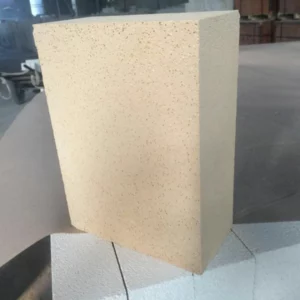While high alumina insulating brick offers many advantages, there are also some limitations and potential disadvantages to consider:
Low Mechanical Strength: High alumina insulating brick generally has lower mechanical strength compared to dense refractory bricks. Its lightweight and porous structure make it more susceptible to physical damage, such as cracking or spalling, especially under mechanical or thermal stress. Care must be taken during installation and operation to avoid excessive mechanical loading or thermal shock.
Limited Load-Bearing Capacity: Due to its lower mechanical strength, high alumina insulating brick may have limitations in load-bearing applications. It is not suitable for supporting heavy loads or acting as a structural component. In load-bearing areas, additional structural support or a combination of insulating and dense refractory bricks may be required.
Reduced Abrasion Resistance: High alumina insulating brick may have lower resistance to abrasion and erosion compared to dense refractory bricks. In applications where the brick comes into contact with abrasive materials, erosive gases, or high-velocity gas flows, it may experience faster wear and reduced service life. Protective measures such as coatings or additional refractory linings may be needed in such cases.
Limited Chemical Resistance: While high alumina insulating brick generally exhibits good chemical stability, it may have limitations in highly corrosive or aggressive chemical environments. Certain chemicals or gases, especially at elevated temperatures, can cause degradation or chemical reactions with the brick material. In such cases, alternative refractory materials with higher chemical resistance may be more suitable.
Lower Thermal Storage Capacity: The lower density and porous structure of high alumina insulating brick result in a lower thermal storage capacity. This means that it may have a reduced ability to absorb and store heat compared to dense refractory materials. In some applications where thermal cycling or rapid temperature changes occur, the lower thermal storage capacity of insulating brick may impact the overall thermal performance.
Higher Cost: High alumina insulating brick can be more expensive compared to other types of insulating materials, such as ceramic fiber or lightweight refractory castables. The cost is primarily influenced by the high alumina content and the manufacturing process required to achieve the desired properties. Cost considerations should be weighed against the specific thermal and mechanical requirements of the application.
It’s important to carefully evaluate the specific requirements of your application, considering factors such as mechanical strength, chemical resistance, High alumina insulating brick thermal cycling, and cost-effectiveness when selecting high alumina insulating brick or exploring alternative insulation solutions. Consulting with refractory experts or engineers can provide valuable insights and help determine the most suitable material for your specific needs.
What are some common applications where high alumina insulating brick is not suitable due to its limitations?
While high alumina insulating brick is widely used in various high-temperature applications, there are certain scenarios where its limitations may make it less suitable.
Here are some common applications where high alumina insulating brick may not be the ideal choice:
Heavy Load-Bearing Structures: High alumina insulating brick has lower mechanical strength and load-bearing capacity compared to dense refractory bricks. Therefore, it is not recommended for applications where the brick is subjected to significant mechanical loading or acts as a primary structural component. In heavy load-bearing structures such as the support walls of large furnaces or kilns, dense refractory bricks or other load-bearing materials are more appropriate.
High Abrasion or Erosion Environments: The reduced abrasion resistance of high alumina insulating brick makes it less suitable for applications where it is exposed to abrasive materials, erosive gases, or high-velocity gas flows. In areas with high abrasion or erosion, such as the combustion zones of boilers or areas with high particle velocities, dense refractory materials with higher abrasion resistance may be more suitable.
Aggressive Chemical Environments: While high alumina insulating brick generally exhibits good chemical stability, it may have limitations in highly corrosive or aggressive chemical environments. Certain chemicals, gases, or slag compositions can cause chemical reactions or degradation of the brick material. In such cases, specialized refractory materials with higher chemical resistance, such as acid-resistant bricks or fused cast refractories, may be more appropriate.
Rapid Thermal Cycling: The lower thermal storage capacity of high alumina insulating brick can make it less suitable for applications with frequent or rapid thermal cycling. In processes where there are significant temperature fluctuations or rapid heating and cooling cycles, materials with higher thermal shock resistance, such as refractory castables or dense refractory bricks, may be better suited to withstand the thermal stresses.
Cost-Effective Insulation: High alumina insulating brick can be more expensive compared to other insulation materials, such as ceramic fiber or lightweight refractory castables. In applications where cost-effectiveness is a primary consideration, and the specific thermal and mechanical requirements allow for alternatives, using cost-effective insulation solutions may be more economical.
In these scenarios, it is essential to consider the specific demands of the application, taking into account factors such as mechanical strength, abrasion resistance, chemical compatibility, thermal cycling, and cost-effectiveness. Consulting with refractory experts or engineers can help determine the most suitable insulation material for your specific application, considering both performance requirements and budget constraints.
